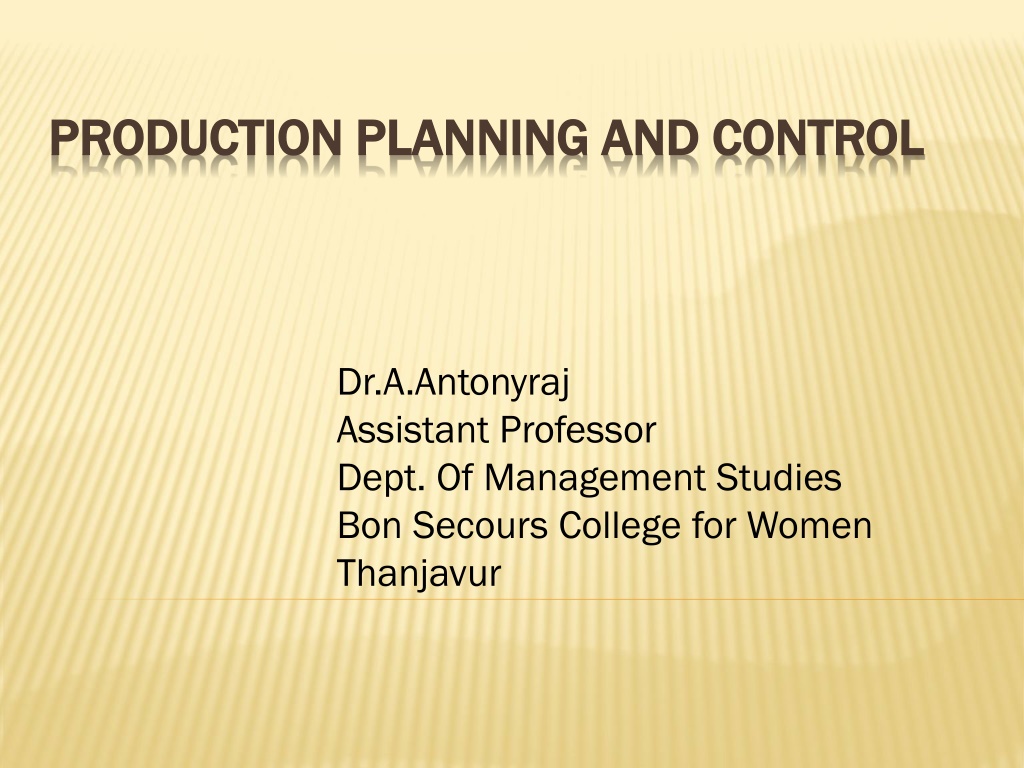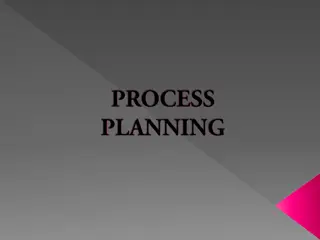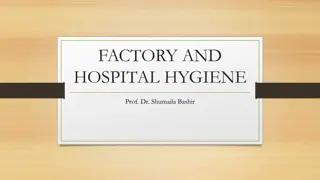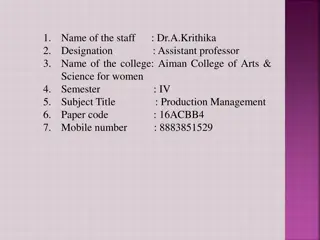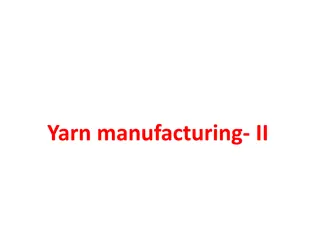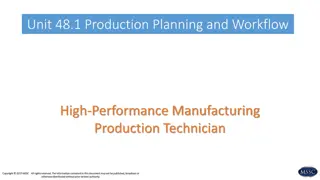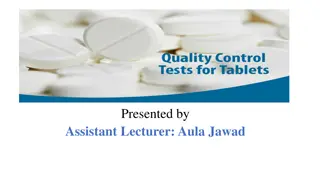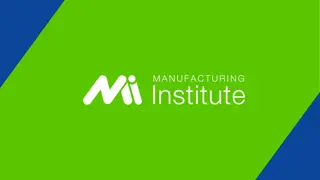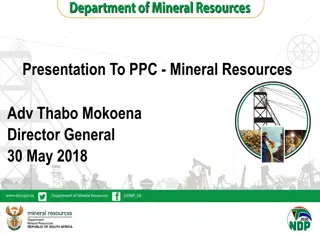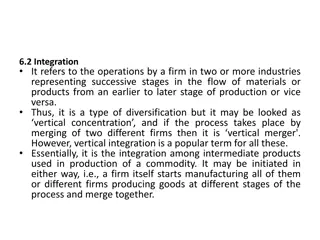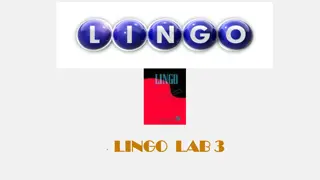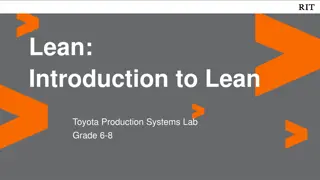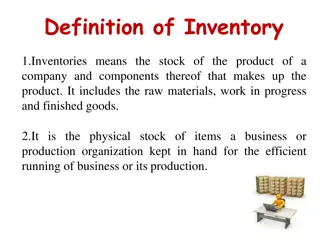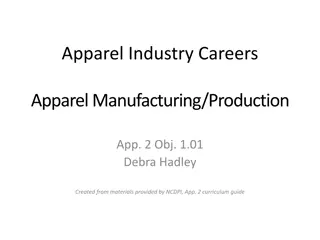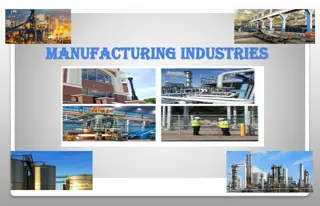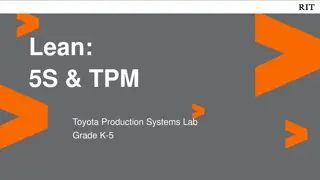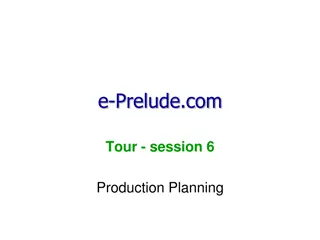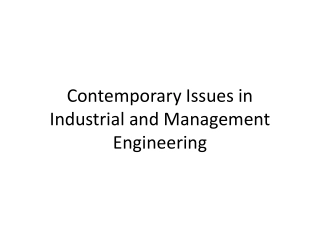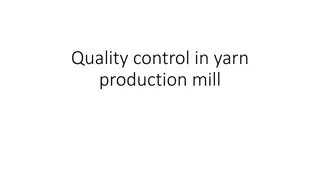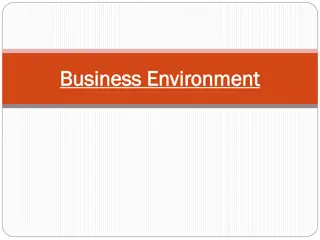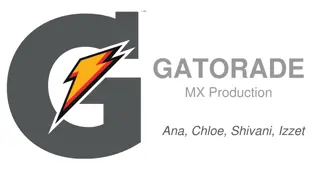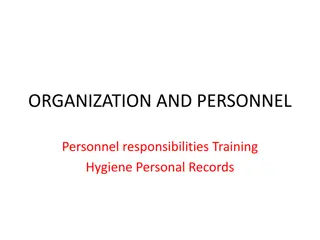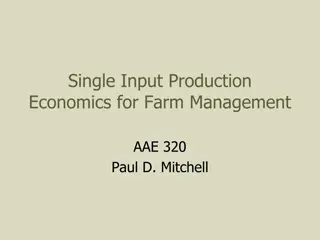Understanding Production Planning and Control (PPC) in Manufacturing
Production Planning and Control (PPC) is a vital tool that helps achieve maximum efficiency in manufacturing by coordinating all activities in a production system. It aims to deliver goods to customers on time, ensure quality production, maximize resource utilization, and minimize manufacturing time and costs. PPC functions include planning, forecasting, material control, process planning, routing, tool control, product design, dispatching, and scheduling.
Download Presentation

Please find below an Image/Link to download the presentation.
The content on the website is provided AS IS for your information and personal use only. It may not be sold, licensed, or shared on other websites without obtaining consent from the author. Download presentation by click this link. If you encounter any issues during the download, it is possible that the publisher has removed the file from their server.
E N D
Presentation Transcript
PRODUCTION PLANNING AND CONTROL PRODUCTION PLANNING AND CONTROL Dr.A.Antonyraj Assistant Professor Dept. Of Management Studies Bon Secours College for Women Thanjavur
WHAT IS PPC? The highest efficiency in production is obtained by manufacturing the required quality of product , of required quantity ,at the required time by the best and cheapest method - coordinate all manufacturing activities in a production system. Hence, PPC is a tool to
OBJECTIVES OF PPC To deliver required goods in required quantities to the customer in the required delivery schedule to achieve maximum customer satisfaction and minimum cost To ensure maximum utilization of the available resources To ensure production of quality products To minimize the manufacturing time
CONTINUED. To maintain optimum inventory levels To maintain flexibility in manufacturing operation To coordinate between labor and machines and various supporting documents To plan for plant capacities for future requirements To remove bottle neck at all stages of production and to solve problems related to production To ensure effective cost reduction and cost control
FUNCTIONS OF FUNCTIONS OF PPC PPC PPC PLANNING PHASE CONTROL PHASE ACTION PHASE ACTIVE PLANNING PRIOR PLANNING PROGRESS REPORTING CORRECTIVE ACTION PROCESS PLANNING AND ROUTING FORECASTING EXPEDITING DATA MATERIAL CONTROL PROCESSING ORDER WRITING REPLANNING TOOL CONTROL PRODUCT DESIGN DISPATCHING LOADING SCHEDULING
PRIOR PLANNING ACTIVE PLANNING PLANNING PHASE PROCESS PLANNING AND ROUTING Estimation of type, quality & quantity of future work FORECASTING Giving authority to one or more person to undertake a particular job ORDER WRITING MATERIAL CONTROL Collection of information regarding speifications,BOM,drawings etc PRODUCT DESIGN TOOL CONTROL Finding the most economical process of doing a work and deciding where and how work will be done LOADING Involves determining the requirements and control of materials Involves determining the requirements and control of tools used SCHEDULING Assignment of work to manpower, machinery etc Determines when and in what sequence the work will be carried out. It fixes the starting as well as ending time for the job
ACTION PHASE ACTION PHASE It is the transition from planning to action phase. In this phase the worker is ordered to start the work DISPATCHING
CONTROL PHASE Data regarding the job process is collected PROGRESS REPORTING CORRECTIVE ACTION It is interpreted with the present level of performance DATA EXPEDITING PROCESSING Taking action if the progress reporting indicates the deviation of the plan from the originally set targets REPLANNING Re planning of the whole affair becomes essential, in case expediting fails to bring the deviated plan to its actual path
STAGES/STEPS IN PPC ROUTING Related to production planning SEQUENCING Related to production planning SCHEDULING Related to production control DISPATCHING Related to production control FOLLOW UP Related to production control
1. ROUTING Routing is the first step in production planning and control. Routing can be defined as the process of deciding the path (route) of work and the sequence of operations. In short, routing determines What , How much , With which , How and Where to produce.
ADVANTAGES OF ROUTING Routing gives a very systematic method of converting raw-materials into finished goods. It leads to smooth and efficient work. It leads to optimum utilization of resources; namely, men, machines, materials, etc. It leads to division of labor. It ensures a continuous flow of materials without any backtracking.
CONTINUED It saves time and space. It makes the work easy for the production engineers and foremen. It has a great influence on design of factory's building and installed machines.
STEPS /PROCEDURE OF ROUTING Product analysis determines what to manufacture and purchase Product analysis is done again to determine materials required for production Fix the maufacturing operations and their sequences Decide the number of units to be manufactured in each lot of production Estimate the margin of scrap in each lot of production Analyse the production cost Prepare the production control forms for effective routing Prepare a separate route sheet for each order
TECHNIQUES OF ROUTING Route card Work sheet Route sheet
1. ROUTE CARD This card always accompanies with the job throughout all operations. This indicates the during manufacturing and their progress from one operation to another. In addition to this the details of scrap and good work produced are also recorded. material used
2. WORKSHEET It contains Specifications to be followed while manufacturing. Instructions regarding routing of every part with identification number of machines. This sheet is made for manufacturing as well as for maintenance.
3. ROUTE SHEET It is also called as route card It lists the manufacturing operations in the decided sequence along with the machines associated with each operation It also indicates the department in which the operation is to be done and the part will go for the next operation It also consists of the information such as part name, part number and product number It gives information about the material specification and cutting tools,jigs,fixtures and necessary devices for each operation.
ROUTE SHEET ROUTE SHEET MATERIAL : _____________ HARDNESS : ____________ DUE DATE : _____________ PART NAME : - PART NO. : QUANTITY : PART DRAWING : OPERATION NO. OPERATION DESCRIPTION MACHINE DEP T TOOLS REQUIRE D TIME (MIN) OPERATIO N TIME SET UP TIME TOTAL TIME
2. SEQUENCING Defined as the order in which jobs pass through machines or work stations for processing The main aim is to find out such sequence out of the possible sequence that will complete the work in shortest time Sequencing problems becomes tedious as the number of jobs and machines increases
3. SCHEDULING Scheduling means setting of starting and finishing dates for each operation, assembly and the finished product. It also means to : Fix the amount of work to do. Arrange the different manufacturing operations in order of priority. Fix the starting and completing, date and time, for each operation
4. DISPATCHING It s the next step after scheduling Also means starting the actual production of a particular work which has been planned in routing schedule. It provides the necessary authority to start the work. It is based on route-sheets and schedule sheets.
Dispatching includes the following: Issue of materials, tools, fixtures, etc., which are necessary for actual production. Issue of orders, instructions, drawings, etc. for starting the work. Maintaining proper records of the starting and completing each job on time. Moving the work from one process to another as per the schedule. Starting the control procedure. Recording the idle time of machines.
4. FOLLOW UP Follow-up or Expediting is the last step in production planning and control. It is a controlling device. It is concerned with evaluation of the results. Follow-up finds out and removes the defects, delays, limitations, bottlenecks, loopholes, etc. in the production process. It measures the actual performance and compares it to the expected performance. It maintains proper records of work, delays and bottlenecks. Such records are used in future to control production.
GANTT CHART It s a type of bar chart that illustrates a project schedule. It is the graphical representation of the duration of tasks against the progression of time. Its shows the comparison between the planned and actual progress of job through several activities of departments.
AN EXAMPLE GANTT CHART GANTT CHART TASK START DAY DAYS TO COMPLETE 22-May 1-Jun 11-Jun 21-Jun 1-Jul 11-Jul 21-Jul 31-Jul TASK 1 22-May 13 TASK 1 TASK 2 31-May 9 TASK 2 TASK 3 5-Jun 9 TASK 3 TASK 4 15-Jun 14 TASK 4 TASK 5 21-Jun 9 TASK 5 TASK 6 1-Jul 5 TASK 6 TASK 7 8-Jul 7 TASK 7 TASK 8 15-Jul 12 TASK 8 TASK 8 15-Jul 12 TASK 7 8-Jul 7 TASK 6 1-Jul 5 TASK 5 21-Jun 9 TASK 4 15-Jun 14 TASK 3 5-Jun 9 TASK 2 31-May 9 TASK 1 22-May 13 START DAY DAYS TO COMPLETE
